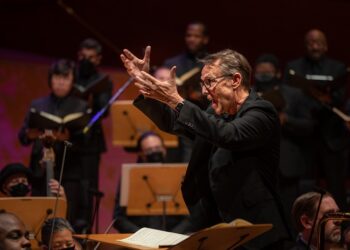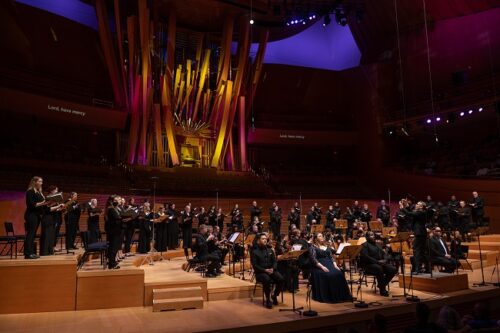 United States J. S. Bach, Mass in B minor: Julia Metzler (soprano), Reginald Mobley (countertenor), Nicholas Phan (tenor), Steve Pence (bass), Los Angeles Master Chorale, Musica Angelica Baroque Orchestra / Grant Gershon (conductor). Walt Disney Concert Hall, Los Angeles, 25.6.2022. (DD)
United States J. S. Bach, Mass in B minor: Julia Metzler (soprano), Reginald Mobley (countertenor), Nicholas Phan (tenor), Steve Pence (bass), Los Angeles Master Chorale, Musica Angelica Baroque Orchestra / Grant Gershon (conductor). Walt Disney Concert Hall, Los Angeles, 25.6.2022. (DD)

What separates the music of J. S. Bach from other late Baroque composers? Bach was born into a large family of composers that would eventually consist of more than 70 artists, and was one of the Bachs who would serve as court musician for several German cites in ways both intimate and broad. He mastered the Baroque style early in his career and spent the next 50 years of his life investigating, experimenting, enriching and eventually mastering it in ways that were definitively his, and only his.
The other musical aspect that never ceases to amaze Bach enthusiasts is the enormity of his repertory: educational children’s works, an array of keyboard pieces, 200 church cantatas, sets of overtures and much, much more. This includes the strong possibility of a loss of up to half of his compositional output.
There are many fine books about Bach and his output that range from intelligent children’s biographies to detailed, finely tuned harmonic analyses. The range is large in both breadth and richness, and this has surely added understanding, in both style and pleasure, to the music lover’s comprehension. Not unsurprisingly, the more Bach’s music is heard and understood in musical terms, the better it is.

Bach’s Mass in B minor was long in coming, and it is often said to be one of the great singular compilations of the ecclesiastical music that ruled this historical period. Bach himself was happy to add his own concepts to the existing manner of music via both time and style. He would find aspects within the music that could be used to promote different compositional mannerisms and approaches, and would eventually revise and refine these musical styles and their unique characteristics. Conductor Grant Gerson’s directing approach was clear, intelligent and always apt, and he added much to a listener’s understanding of the Baroque style in his pre-concert discussion.
The Mass in B minor begins with the ‘Kyrie’, a massive choral statement that continually creeps and expands in an outward and upward direction until it reaches a high point and then retires downward. When the choral statement ends, we’ve come not to a final harmony but rather a single dominant chord that acts to open the sonorous tonic doors of this masterpiece. Conductor Gershon claimed to have spent two weeks ‘just studying the first four bars’: as a musical declaration, it is surely without peer. The ear is opened to the sublimely organized harmony, one that sets out the basis for what is to follow in this three-hour masterpiece. The clean, powerful and straightforward structure of the opening is unique to Bach, and aspects of it can be found in virtually everything he composed.
There were occasional errors by singers and instrumentalists, and whatever did occur in terms of balance and ensemble seemed not to have any particularly negative effect on the audience. Actually, I might submit that the occasional miscue adds a bit of humanity to the performance. Period instruments at Disney Hall can pose an acoustics problem, and Musica Angelica and the Master Chorale had to work hard to maintain a true balance while not overpowering one another. Much more distressing was the visible number of empty seats that peppered the concert hall.
While I would like to praise all the instrumentalists, there were a few who stood out. Cellist Eva Lymenstuff’s rich solo passages threaded the Hall tightly and quietly together. Lars Johannesson’s rich, fulsome flute solos were perfectly tempered and, I am thrilled to say, spoke both directly and intimately to me.
I could not leave this review without citing the wonderful vocalist Julia Metzler, whose solos were moving but whose duets with Nicholas Phan (‘Domine Deus’) and Reginald Mobley (‘Et in unum Dominum’) were marvelous. And speaking of Reginald Mobley, his ‘Agnus Dei’ that leads to the closing ‘Dona nobis pacem’ was sung with grace and dignity. Bass Steve Pence performed two solo arias – ‘Quoniam tu solus sanctus’ and ‘Et in Spiritum Sanctum’ – which were beautifully rendered while not overwrought.
As always, the Master Chorale sang to perfection, though at times I felt that they were holding back. The balance of a small orchestra with the large choral ensemble immediately behind them may have had something to do with it, and is perfectly understandable.
As a final note to my fellow Bach lovers: in preparing myself for the concert, I again read through James R. Gaines’ finely detailed book on the life and work of Bach, Evening in the Palace of Reason: Bach Meets Frederick the Great in the Age of Enlightenment. About midway, Gaines writes that we auditors would be best served to put down his book, get out the score and read the words and music together. It was surely a recommendation that I did not anticipate, but with which I subsequently heartily concurred.
Douglas Dutton
